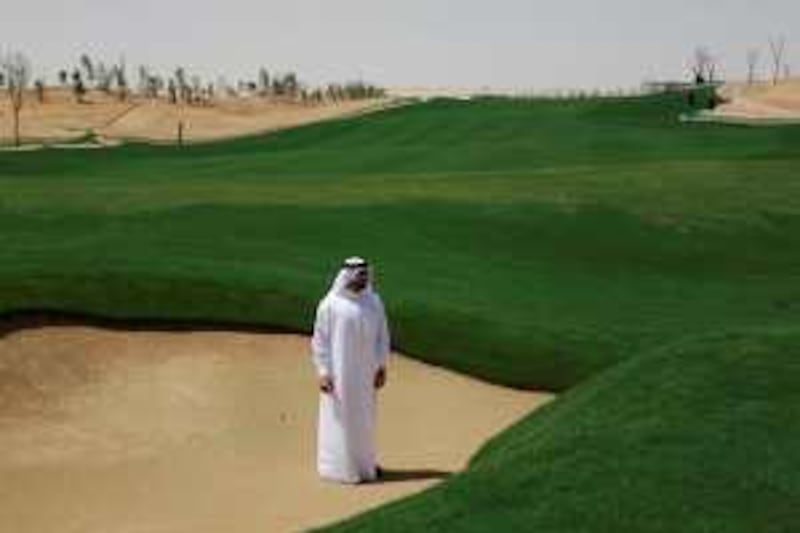The course is already green and lush but turning Tiger Woods's Dubai dream into reality is proving to be a great challenge. Four million cubic metres of water are needed daily just to irrigate the links, and there are 300 workers on site to tend the plants and trees Luxuriant fairways, shimmering lakes and nurseries stocked with thousands of exotic trees and shrubs suggest that the Tiger Woods Dubai development is quickly taking shape despite the economic slowdown. But bringing the project to fruition has not been easy.
Four million cubic metres of water are pumped daily over a distance of 18km to keep the lush greenery of the golfing oasis alive. So it is no surprise that spiralling water costs have made irrigation one of the biggest headaches for Abdulla Fareed al Gurg, the project director at Tiger Woods Dubai. However, during a behind-the-scenes tour yesterday, he said that milestones are being achieved, with Woods's influence clear in every detail. In fact, he said, some of the irrigation expense has been offset by reduced contracting costs.
"We have not been immune to economic problems and it has forced us to take a pragmatic approach. We have tailored all projects to meet the present conditions and have decided to prioritise work on the golf course and club house. "Although, in some ways the economic conditions are in our favour, as contracting costs have been reduced considerably. "Because of Tiger's personal involvement there is a huge burden of expectation and this has brought its own pressure. But we now have turf on three holes, have planted over 2,000 trees and have fine-shaped ten of the holes."
The sheer scale and ambition of the project keeps the 300 workers on site busy watering trees imported from Thailand and nurseries of turf chosen by Woods and shipped in from Atlanta. However, even though most of the site still consists of landscaped sand the temporary irrigation systems are costing Dh410,000 (US$111,000) a month. "We knew the key to the development of the course would be the water supply. But it has proved a greater challenge than we had expected, mostly because of the undulation and contours of the course that Tiger has designed," Mr al Gurg said.
Twenty-five million cubic metres of sand has been carefully formed into the contours of a links-style course. However, it has to be constantly dampened in order to keep its shape and not be blown away. Thousands of flags marking the precise location of the shrubs that will line each hole, and trees are being planted at a rate of almost 50 a day. "The course requires four million gallons of water a day and this has to be pumped 18 kilometres from the Emirates Road. We are building our own permanent pump-stations and infrastructure but we currently rely on water pumped in from the city's water system and this has been the most challenging part of the development. Some aspects of building the course have been delayed due to issues with water supply."
A look at the model of the course, displayed in the site office, gives an indication of the enormity of the task at hand. In contrast to dune- based courses, like the Els club in Sports City, the Tiger Woods course is lush, wooded and built around a series of lakes and creeks. When completed it will be one of the largest open green spaces in the region. A crystal-clear watercourse of interlocking lakes and streams will flow by each hole, thanks to an equaliser pump and ozone filter.
Tiger Woods's involvement in the development has been key in attracting investors and maintaining momentum and interest in the project, according to Mr al Gurg. "Tiger has been very involved, even down to tiny details like the types of shrubs that line the greens, and the placement of particular trees. His team, Tiger Woods Design, visits on a monthly basis to ensure it is taking shape according to plan."
With the course taking priority, progress of the residential areas and the hotel has been slower, although with membership limited to 500 - who, according to Mr al Gurg, will be vetted for their 'sophistication' - there has been high demand. Thirty per cent of the properties have been sold off plan. "We want this community to be drawn from the same sophisticated background, so that members of the Golf Club and the residents can interact. We are targeting people from Russia, the Indian Subcontinent and the GCC. ."
The completion of the boutique hotel and residential units, the largest mansions of which will cost $22 million, is scheduled for 2013 and 2015 respectively leaving the immediate focus on completion of the course and attracting a professional golf tournament in 2012. "We have already begun the process of securing a golf tournament. Fortunately, because of Tiger's profile we have an advantage over other venues but there is a long series of interviews and assessment and we are currently looking to see when we might be ready to host. Our partnership with IMG, that manage 16 leading golf venues worldwide, will help us reach that ambition."
tbrooks@thenational.ae






